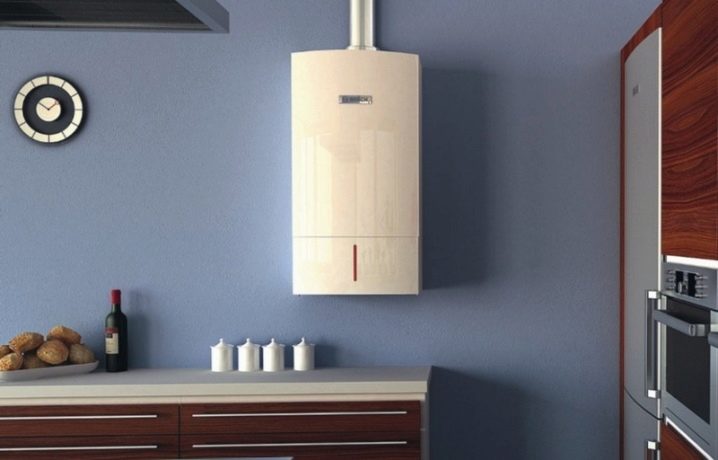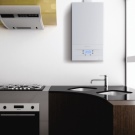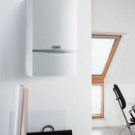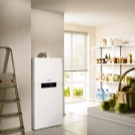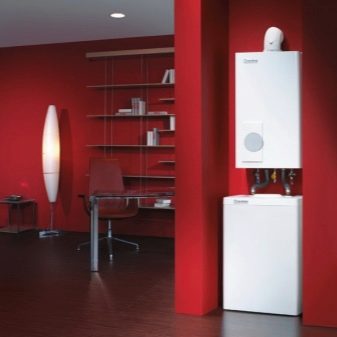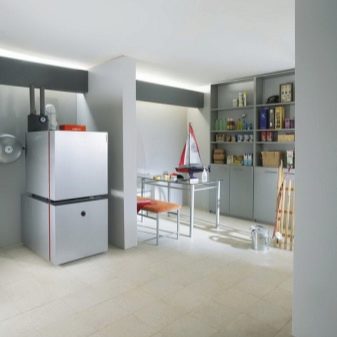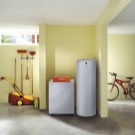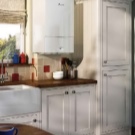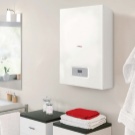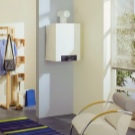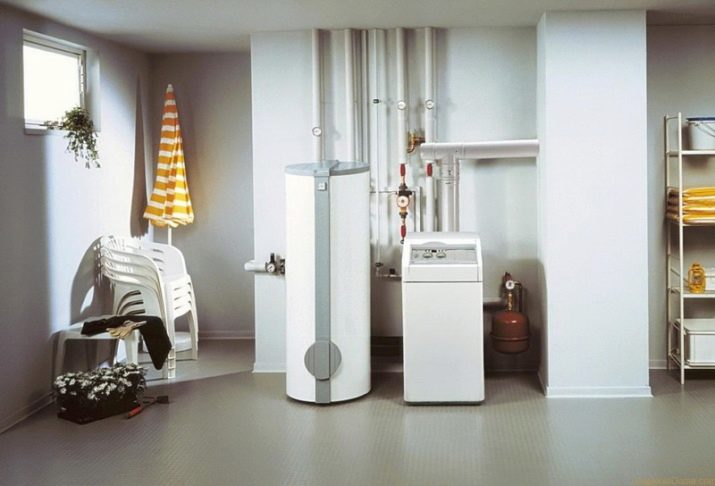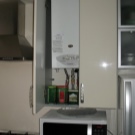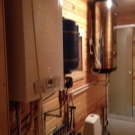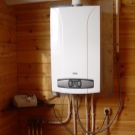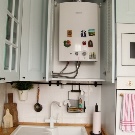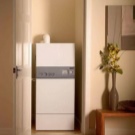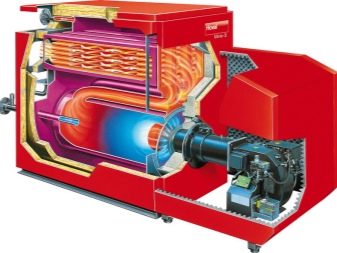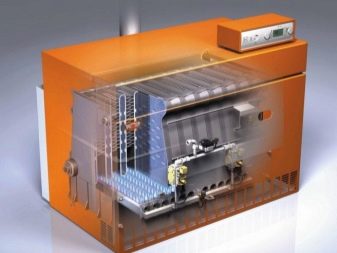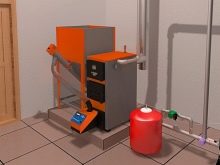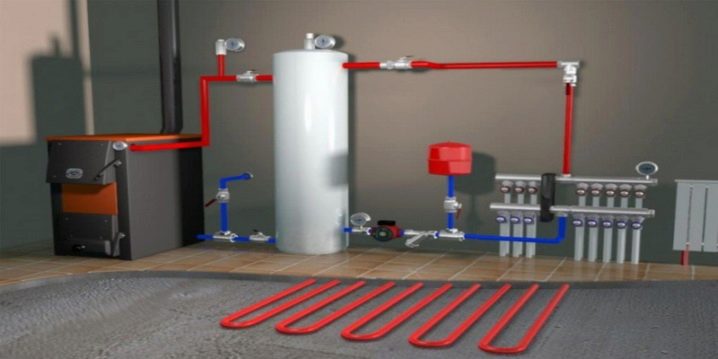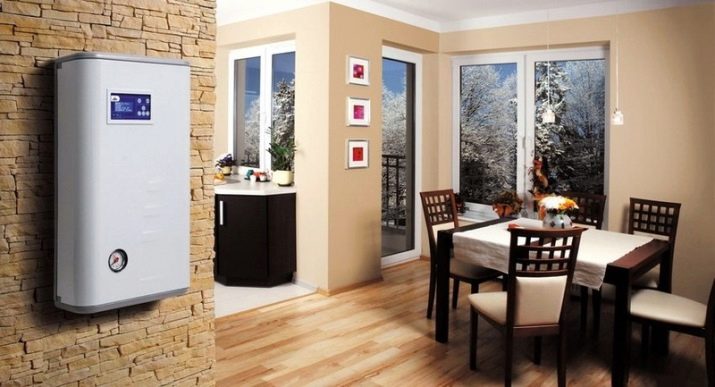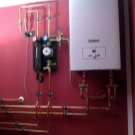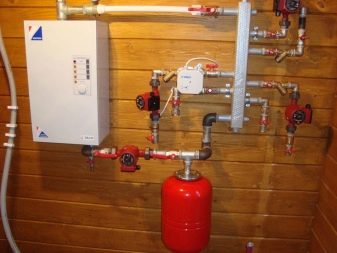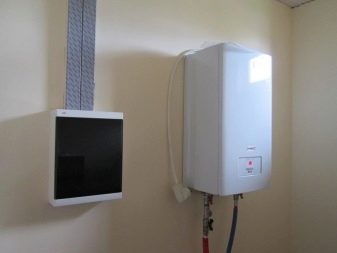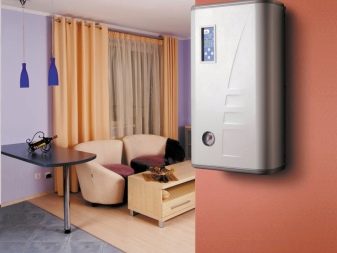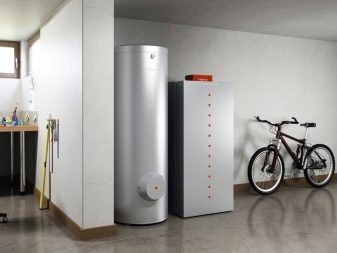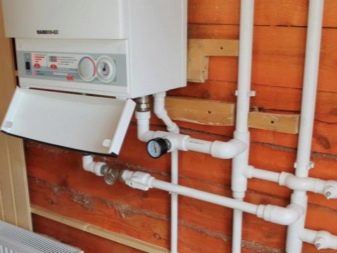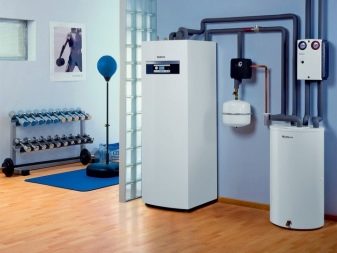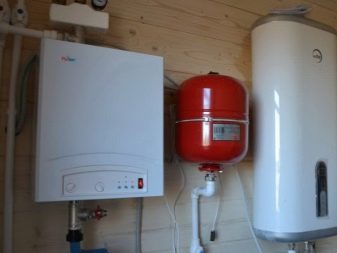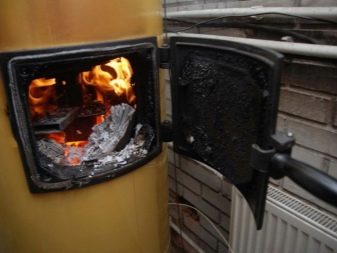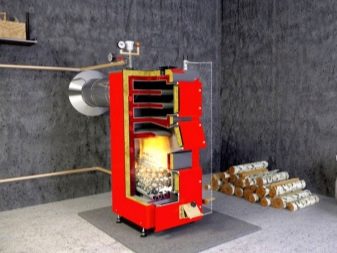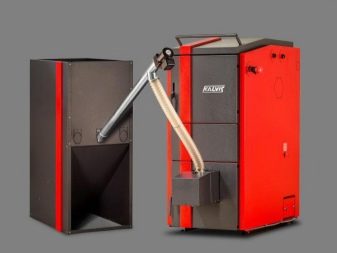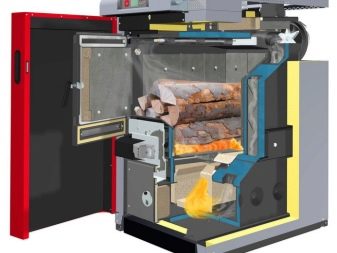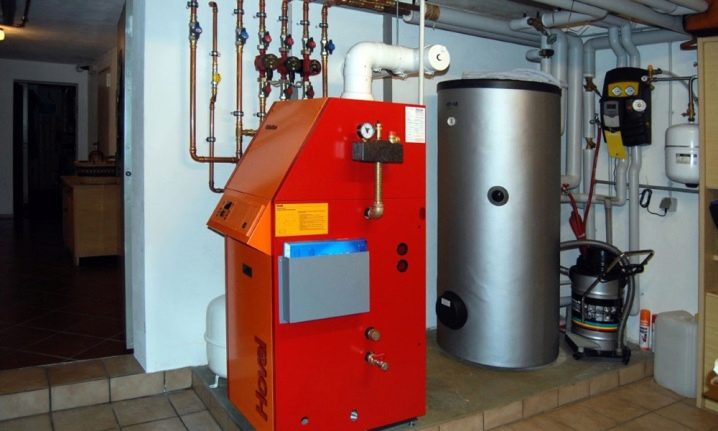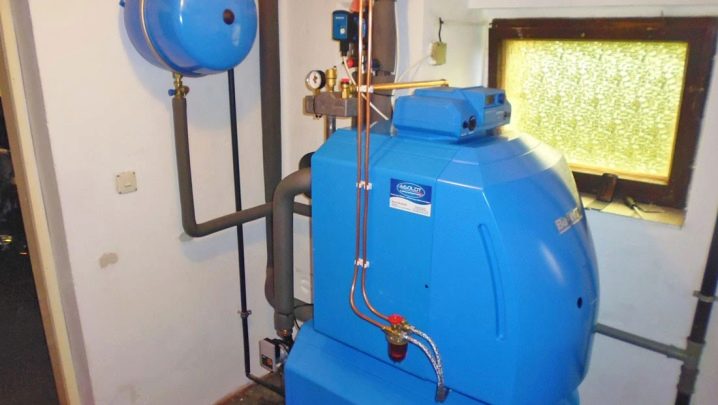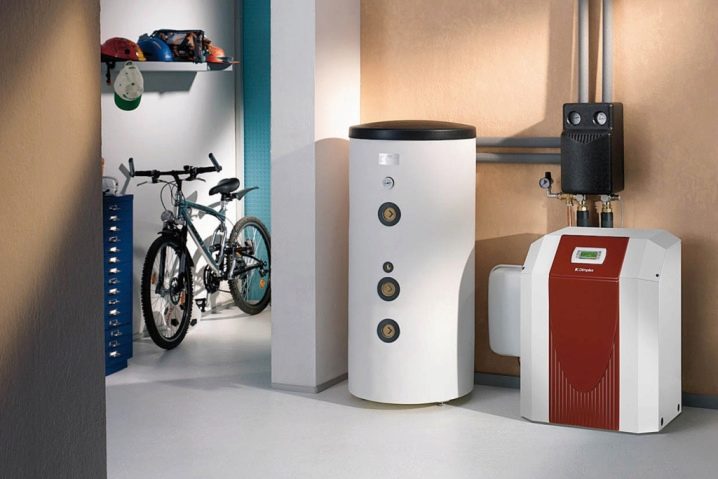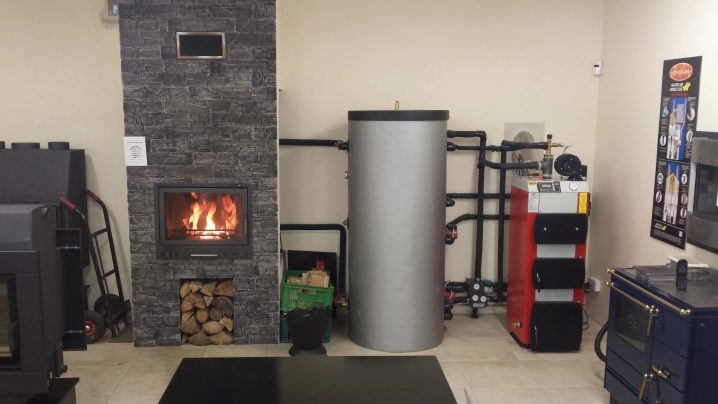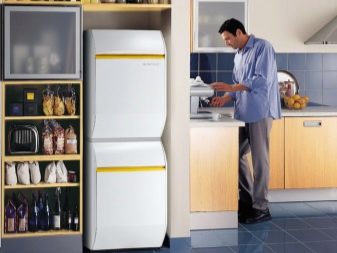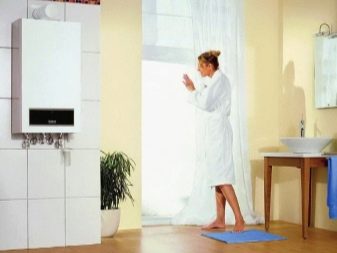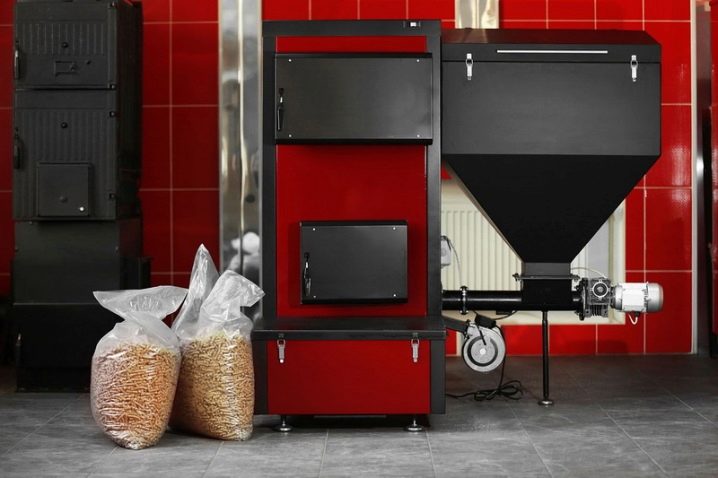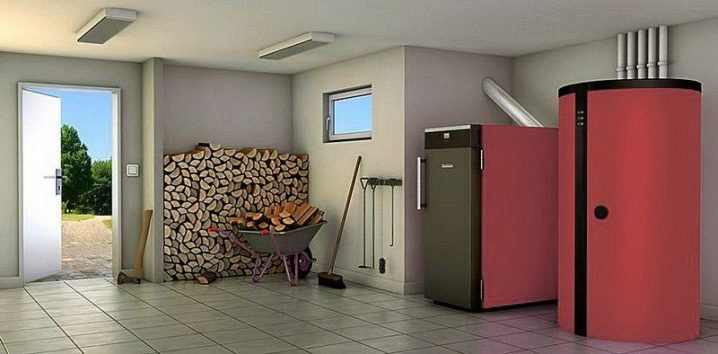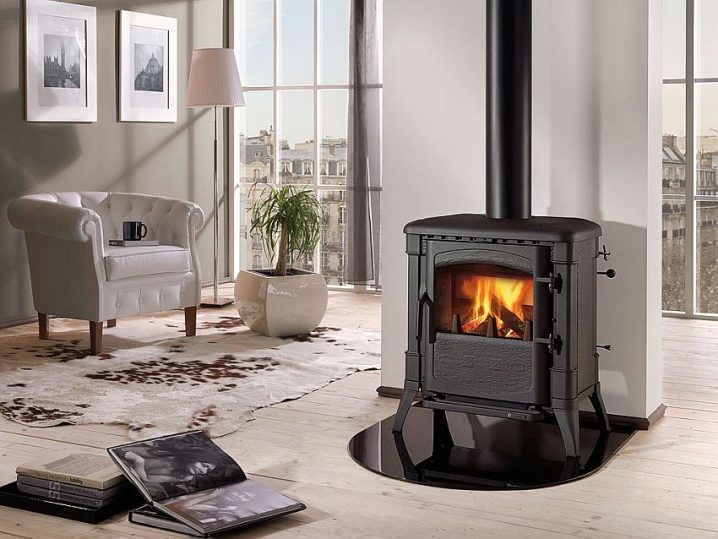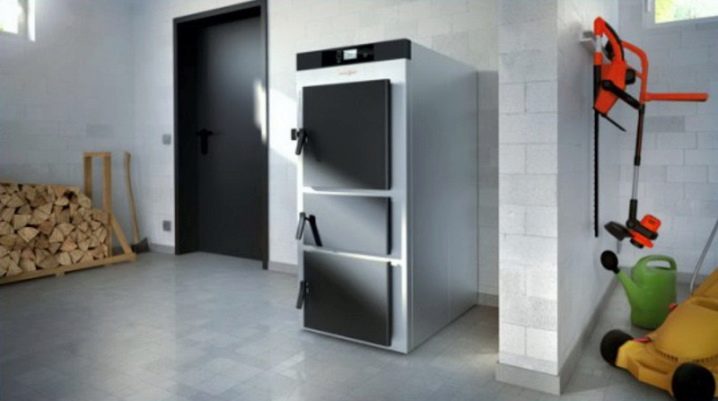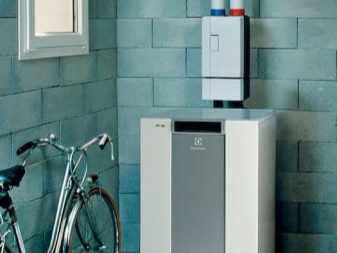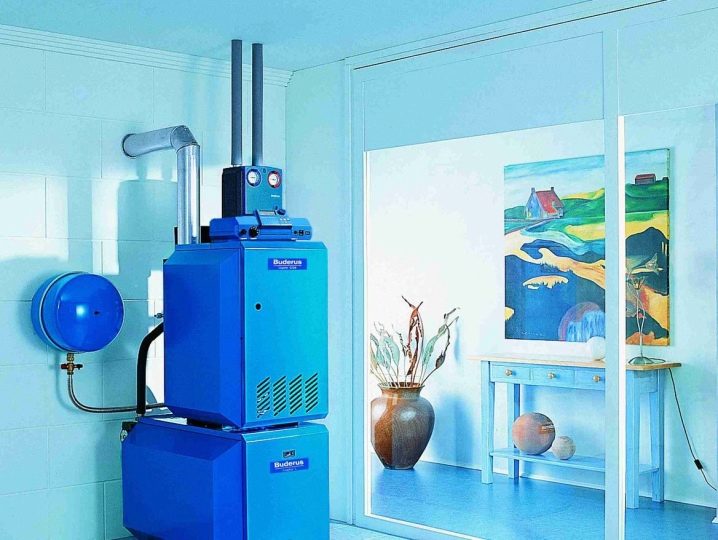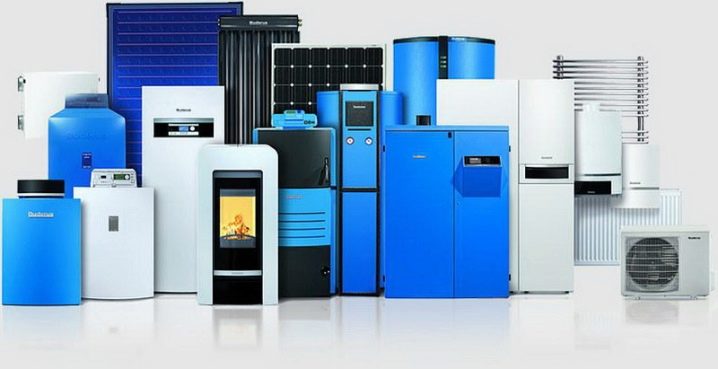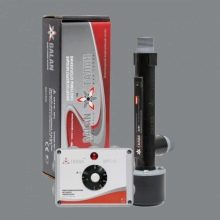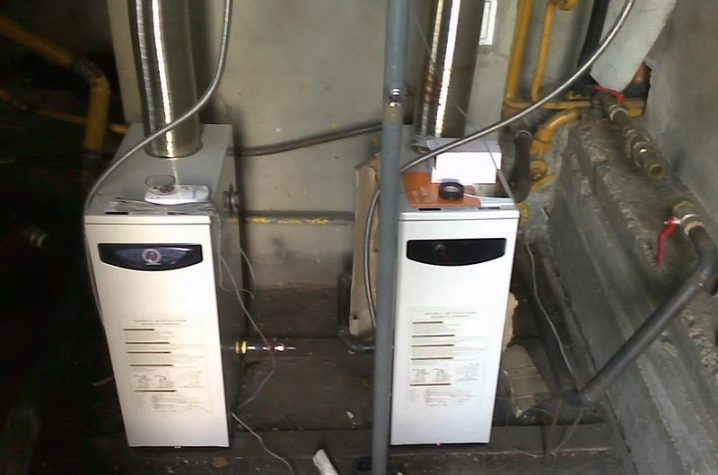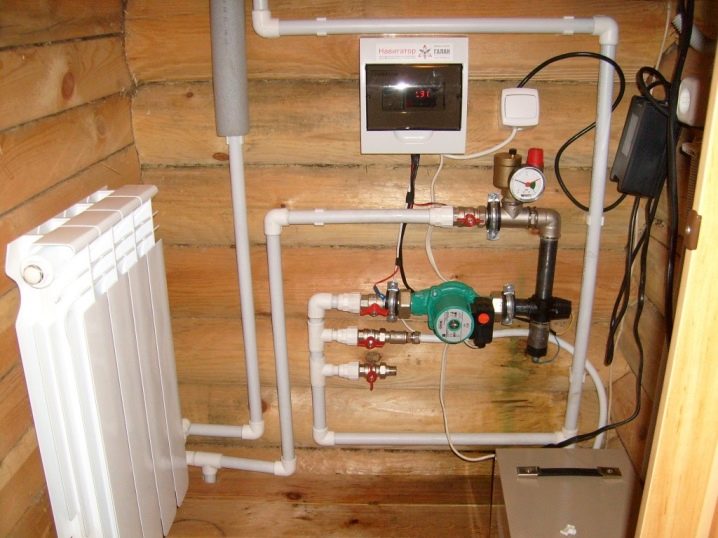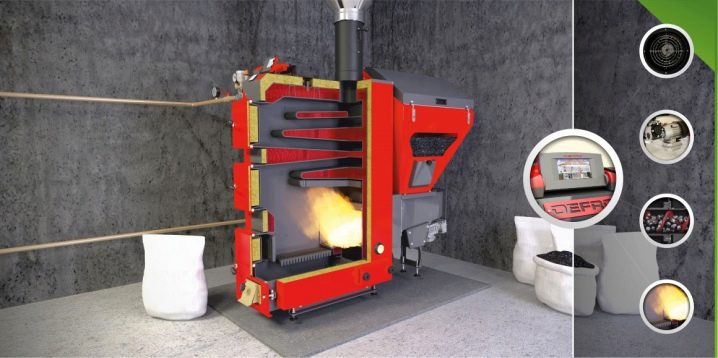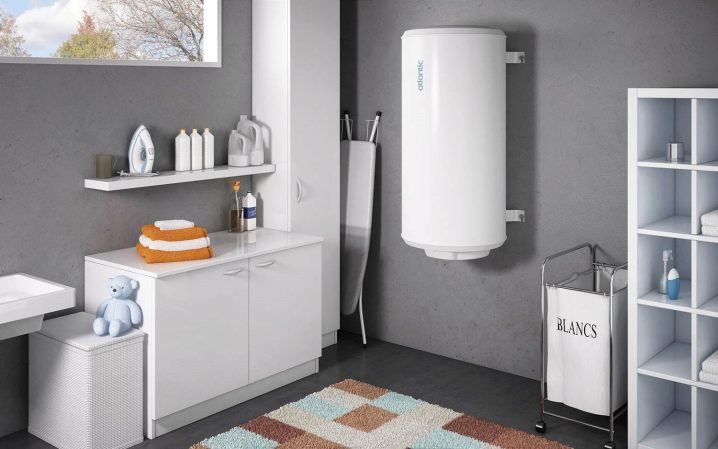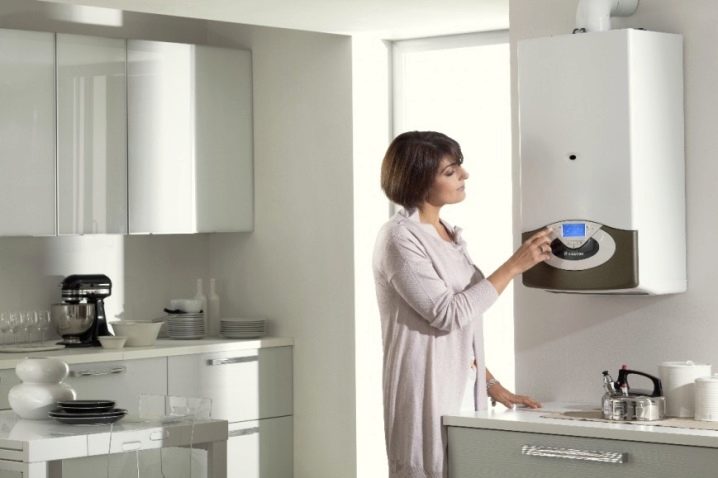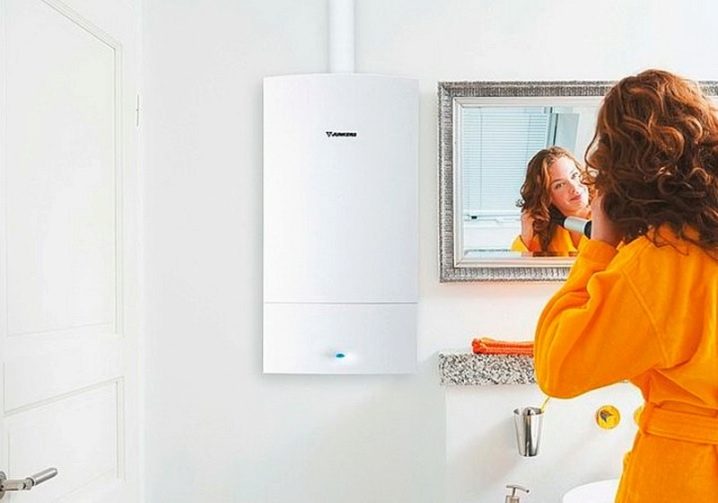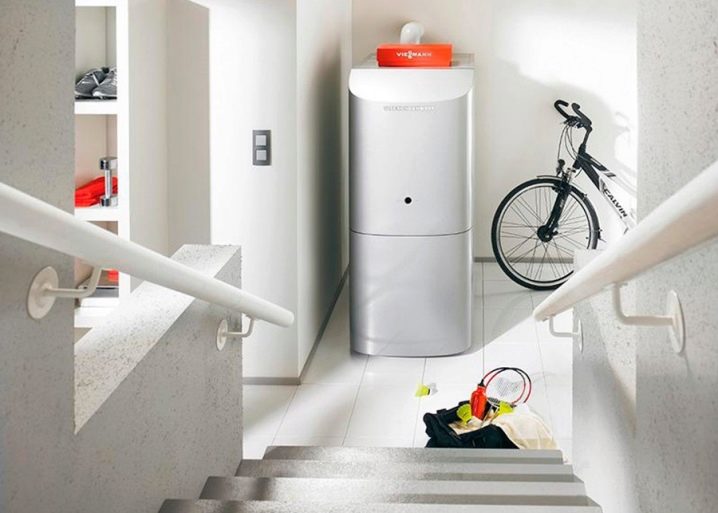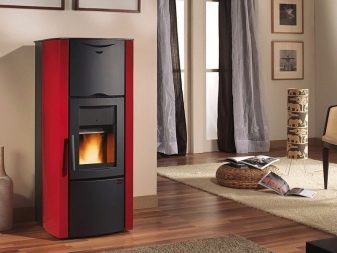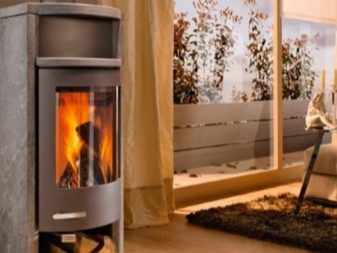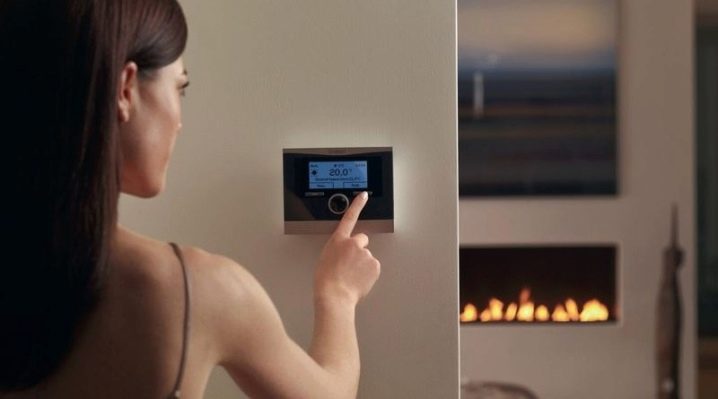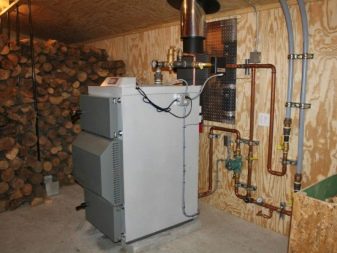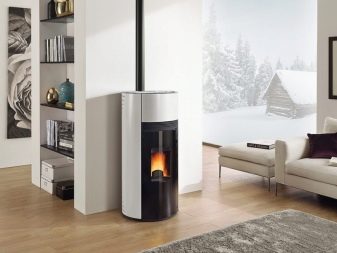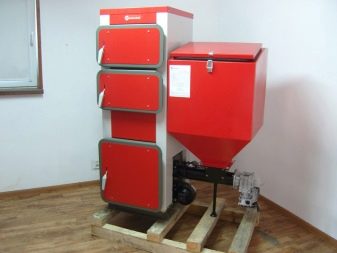Boiler: types, features of choice and application
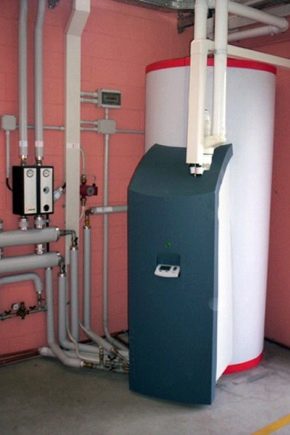
When building a house, they think about heating communications. This system requires a careful and careful approach. The central core of the engineering network is the boiler. It must be chosen correctly so that in the future there will be no problems.
What it is?
The device of any boiler used in the heating system is almost the same. As a rule, it is a closed container in which the coolant is located, for example, a liquid, vapor or gas. The principle of operation is to heat the working fluid to the desired temperature parameters and to ensure its circulation throughout the house.Each type of boiler has its own characteristics, pros and cons. In any case, it should be borne in mind that if the house is well insulated, then less energy is required to heat and maintain heat. Consequently, the size of the heating apparatus can be compact, and the work - economical.
What are the types?
Heating boilers are classified according to various parameters. From the point of view of a technical device, there is a division into single-circuit and double-circuit models.
- Single circuit boiler is aimed only at heating. It consumes less fuel and is cheap enough. If you still need hot water, then connect an additional boiler - boiler.
- Dual circuit modification more expensive, but it provides not only heating, but also hot water. It is also possible to additionally connect a boiler with a volume of up to 180 liters to such a system, but if the house is small, then it is enough to heat the water using a flow method.
In turn, devices with a double circuit are classified by the number of heat exchangers.
- Biometric have one capacity, the heat carrier is used both for heating, and as hot water. Such units gain in weight and cost, but lose in practicality.The fact is that they have a complicated construction that cannot be restored in the event of a device failure.
- Devices with double heat exchanger more practical. One tank is designed for heating, the second - for hot water. If one heat exchanger fails, the second remains in working condition.
In a separate view should be allocated parapet type of boilers. They are universal in the sense that they perform not only the function of the heater, but also work as a convector. The main distinctive feature of such devices is the presence of a sealed combustion chamber, which eliminates the contact of combustion products with the room. The design of the chimney is assumed to be coaxial, it provides a flow of fresh air and the output of smoke to the outside. Ignition is usually carried out from the piezoelectric element. The temperature control is set automatically: if the temperature has reached the limit values, the boiler is turned off until it cools down to a possible limit. Parapet models are wall and floor. They are very often installed in city apartments, because they are compact, clean, easy to install, have an affordable price and high efficiency.
There are drawbacks too.Low power from 7 to 16 kW does not allow the use of parapet boilers for heating large rooms. Possible area - up to 160 square meters. The gas is under low pressure, which causes damping of the igniter.
Differences of designs by type of fuel
- Gas boilers According to statistics, the most common form used for heating communications. In many regions of our country, this type of fuel has the lowest cost, so if you have the opportunity to connect to the central gas pipeline, you should consider this option. There are plenty of advantages of connection: the equipment does not require frequent maintenance, it can work offline, uses the cheapest fuel on the market, has various modifications. Among the shortcomings should be highlighted only the following factors - a long period of registration permits, significant costs for connection and installation. If the area is not gasified, but it is possible to purchase liquefied gas in cylinders, install models with a burner. Modifications of gas boilers have different types of burners and combustion chambers.
Types of burners can be.
- Open type (atmospheric). Models require the installation of a chimney with a good burden. Since the air intake comes from the environment, a powerful ventilation system is required in the room, ensuring its inflow from the outside. The advantages include noiselessness and ease of maintenance.
- Closed (turbocharged). Modifications are equipped with a coaxial chimney brought through the walls. Air is supplied to the boiler through the chimney, which excludes the presence of additional ventilation. However, in case of frost, the outside opening must be cleaned of snow and frost, otherwise the boiler will simply not turn on. It should be noted that the output of carbon monoxide gases is carried out using a cooler or a system of fans that are dependent on electricity, so if there are interruptions in the operation of power systems, it is better to install a device of the first type with a natural draft.
Modifications of the burners are as follows.
- Single stage models assume to function only in two modes: “full power” and “off”. As a rule, they are the cheapest among gas boilers. It should be noted that the option is not the most economical, since gas consumption is significant.
- Two-stage In addition to the above two types, the types offer an additional provision - operation at 50% of capacity. The equipment more economically consumes fuel, maintaining the necessary temperature.
- Modulated torches assume smooth regulation of power. Despite the high cost, the models are popular, since in the long run they are more economical when used later.
Depending on the principle of operation, gas boilers are divided into traditional and condensing. The first ones are ordinary, they heat the coolant from 50 degrees and more, they are convenient for working with radiators. The second ones are effective in low-temperature conditions, when the temperature in the return pipe does not exceed forty degrees. Heat transfer takes place using condensed flue gas vapors. This reduces gas consumption, increasing boiler efficiency.
In particular, condensing gas devices are ideal for a private house with a "warm floor" system. It is also necessary to take into account the disadvantages of such boilers. For example, the fact that the condensate is corrosive, therefore, for the chimney should use high quality stainless steel.In addition, in connection with the complex device and the use of materials of increased strength increases the cost of condensation models.
Another type of gas boilers are apparatus for liquefied gas. The main difference is an inflatable burner, which simultaneously performs two functions: it mixes gas with oxygen and, under pressure, supplies this mixture to the combustion chamber. Among the shortcomings, users note the noise of burning fuel.
- Electrical units easy to operate, autonomous, practically no noise and require a minimum of maintenance. All these advantages are covered by only one drawback - the cost of electricity. Therefore, before installing an electric boiler, it is necessary to evaluate not only technical, but also financial possibilities.
Electric boilers using heating elements usually have a multi-stage adjustment system, are easy to use and repair, and have low cost of both the product itself and individual components. The indisputable advantages include the possibility of using antifreeze, antifreeze, and process water as a coolant.Among the disadvantages are the low efficiency, which is caused by the heating losses of the heating elements, as well as the scale formed during long-term heating of the coolant. The period of use is also limited due to the fact that the heating element burns out.
Induction models use the phenomenon of electromagnetic induction, which reduces energy losses to almost 100%, respectively, saving increases. The design of boilers resembles transformers, whose structure includes two circuits: magnetic and heat exchange. The working fluid for heating passes through the induction coil. The main advantage is the small size of the device, the main disadvantage is the burnout of the boiler in the absence of coolant flow.
Electrode on the principle of action similar to the battery. An electrolytic fluid circulates inside the boiler, which heats up as a result of the passage of electric current between the electrodes. We can say that the device is constantly under voltage, reduces its popularity among consumers. Among the advantages should be highlighted: the universal size of the devices, which can be from the smallest to the huge,short warm-up period and precise temperature setting.
By cons professionals and users include the following characteristics:
- only special liquids are suitable as heat carrier; ordinary antifreeze, antifreeze or water are not suitable;
- commissioning requires a competent specialist with knowledge of thermal conductivity;
- the boiler power depends on the temperature of the working fluid, since the electrical conductivity increases when the heating medium is heated, this can lead either to network overload or, in the worst case, to a short circuit.
If there is a multi-tariff control system in the region, then experts suggest installing an electric boiler and simultaneously using hot water heat accumulators. Then, at the night rate, the water in them heats up, and during the day the equipment is turned off and the thermal energy stored in the battery is disconnected. This will reduce the cost of electricity.
- On solid fuel. Wood and coal boilers - one of the first devices used for domestic needs. In past centuries, they worked like stoves, were ineffective and spent a lot of fuel.Their improved models are still very popular. The boilers can be heated not only with wood and coal, but also with any waste from the woodworking industry (sticks, boards, trimmings).
Different wood and coal units combustion chambers. If the former are possible in the open version, like fireplaces, then the latter are made only with a closed combustion chamber and thick walls, since the temperature in the furnace reaches enormous values. Among the advantages of the design can be identified simplicity and reliability. Since solid fuel in most cases is relatively inexpensive, among the advantages should be noted and efficiency.
Significant disadvantages include the following factors:
- Intermittent mode. Firewood or coal must be constantly thrown up to prevent the system from freezing, for example, in winter. In order for heat to be transferred evenly, an additional installation of an accumulator, such as a water boiler, is required. Then, during the period of fuel combustion, the heat energy accumulates, and when the furnace is cooled, it provides a gradual consumption. Such a non-volatile boiler is quite cumbersome, but does not require an electric regulator.
- Regular maintenance and care is needed. The operation of the device requires fuel supply and flame intensity adjustment. Waste from combustion should be cleaned regularly.
- The presence of dirt. Firewood and coal always leave dust, chips, sawdust and other small particles, therefore it is recommended to install the boiler closer to the exit. Maintenance work (cleaning the chimney and ashpit) is also not a clean job.
Now models of solid-fuel devices with an increased gap between the tabs have been developed. They are quite effective, since they do not require attention from 6 hours to a day, and for coal models more than a day. The only requirement is high-quality fuel, otherwise the boiler will not fulfill its purpose.
The so-called long-burning devices are of two types.
- Pyrolysis units have 2-3 combustion chambers. Since firewood burns when there is a shortage of oxygen, combustible flue gases are formed, which are fed into the second chamber. There, they mix with air, causing them to ignite. Gases emit more heat than the fuel itself. By the way, you can use not only firewood, but also coal, fuel briquettes.
- Boilers with top burning differ from traditional ones in that the process starts from above. Therefore, firewood burns evenly, slowly smoldering, the thermal regime is not disturbed.
- On liquid fuel. The boilers of this design are usually outdoor, because it requires a capacity for storing liquid fuel, the device may make noise during operation, and the products of combustion may smell. It is desirable to have a specially equipped room with good ventilation and thermal insulation, since the liquid thickens and freezes the burner when it freezes. Fuel oil boilers run on diesel, diesel or other products of the oil industry. One example of a liquid fuel device is a thermal oil machine.
The advantages include the following factors.
- Oil has a high density, it is thicker, which means that heating and cooling occur evenly and slowly. In this regard, boilers can be used even in those systems where any abnormality is prohibited.
- Thermal oil freezing temperature is lower than that of other liquids.
- Diametric oil with prolonged heating does not form scale and does not cause corrosive phenomena of the heat exchanger material.
The advantages include autonomy, high efficiency and ease of operation, as well as such boilers do not need permitting documents for installation as compared to gas appliances. It is also important that liquid-fired boilers are easily converted by qualified craftsmen for gas. Among the minuses should be highlighted a high level of fire safety, which causes difficulties during welding, low heat resistance, leading to the formation of deposits in the form of a dense crust on the walls of the boiler, which over time affects the heat transfer.
- Pellet boilers. The main difference from other heating boilers is their full or partial autonomy. Such devices operate on special compressed granules from various wastes of the timber and woodworking industries. Therefore, if there is such a plant in the region, then such a model will be convenient. It should be noted that the cost of the unit itself is quite high. However, after weighing all the pros and cons, many make a choice in favor of pellet boilers. The period between refueling directly depends on the fuel bunker, the smallest for 2-3 buckets is designed for a day of autonomous work, the largest for several tons can work up to a month or more.Pellets of good quality burn almost completely, the percentage of ash formation is only 3-5 percent. In this regard, service is required once a week, or even a month. The most expensive modifications equip with remote control. The useful life of such devices on average is 20 years.
Produce several varieties of pellet boilers, different in the following specifications.
- Fuel quality. Pellets can be made not only from wood chips. Manufacturers offer biogranules of oil cake, agricultural waste, etc. Some boilers are designed only for high-quality raw wood, while others can work on a simpler one.
- The location of the bunker. Apparatuses with an integrated reservoir located directly on the body are produced, as well as models with a stand-alone bunker connected to the boiler with a special device for feeding fuel into the combustion chamber.
- Other fuels. For heating purposes, they use equipment operating on sawdust and chips, fuel briquettes and other waste from pulp, light and woodworking industries.
- Combined modifications when heating the cottages are quite common. There are models using two, three or even four types of fuel. As a rule, such devices are characterized by large size, low efficiency, a complex process of adjustment and maintenance. One of the most popular options is a solid fuel boiler with electric heating elements. It allows you to maintain a comfortable temperature after burning wood or coal.
Often used oil models with the presence of a second chamber for solid fuels. True, the efficiency in this case is low, and the price is substantial, therefore it is unlikely to be suitable for a full-fledged heating of a private house.
You can list several types of combined boilers operating on two types of fuel:
- solid fuel and gas;
- solid fuel and electricity;
- gas and diesel;
- electrogas.
It should be noted that in such devices one type of fuel is always the main one, and the second is an auxiliary one.
By type of installation
Coppers can be floor or wall (suspended). As a rule, the first have greater power and size.Wall mounted more compact, which allows them to be installed in the premises used, for example, in the kitchen or in the bathroom. For floor modifications, you will need a separate room or an extension with a boiler room function.
By degree of autonomy
Autonomous boilers are volatile. Not all conditions allow the use of such models, since in some regions there are certain problems. In the city and suburban areas, automatic devices justify themselves by 100 percent, without requiring any effort from users. Semi-automatic boilers are popular in rural areas, remote from the city areas, in country cottages and garden houses. They can work both from the network and without it. Simple boilers such as furnaces do not have automatic adjustment at all. They are completely non-volatile. These, as a rule, carry devices on solid fuel.
Material
Since boilers are exposed to high temperature loads, materials for their manufacture should be selected taking into account this parameter.
General requirements for metal:
- high degree of heat resistance, since the material must retain strength with prolonged temperature exposure;
- resistance to mechanical stress;
- low coefficient of aging, otherwise the life will be too small;
- high degree of corrosion resistance;
- a high coefficient of structural stability, that is, over time, changes within the metal proceed slowly;
- absence of external and internal defects.
As a rule, for the manufacture of heating boilers used cast iron and steel.
Cast Iron Boilers
Pig-iron apparatuses have the longest history, they are used for a long time. Modern models are usually assembled from several sections by threaded elements and sealants. This is due to the individual features of the processing of cast iron products. But it simplifies the ability to repair and replace individual components. Heating devices made of cast iron are durable, regularly serve for 25-50 years.
Material for heat exchangers taken with special anti-corrosion additives. Even if corrosion forms on the surface, its thin layer serves as protection against deep penetration of rust. Since cast iron is resistant to scaling, it is necessary to wash containers much less frequently than steel ones. In this case, chemicals can generally not be used.Cast iron is used to produce boilers of all types available.
The weaknesses of the cast-iron apparatus are as follows.
- Significant weight. Manufacturers are forced to produce floor models. Cast iron parts are cast, so the walls are thick, which makes the boiler heavier.
- High inertia. Substantial mass slows down the process of heating and cooling, so accurate control is impossible.
- The efficiency of cast iron models is lower than that of steel.
- Immunity to sudden temperature changes. With a sudden change, the heat exchanger can crack, and its replacement is not a cheap pleasure.
- Fragility. Cast iron is destroyed by any strong mechanical effect.
- Powerful cast iron boilers are more expensive than steel.
Steel Boilers
The most common option is the steel apparatus. It gives more freedom when choosing.
Numerous advantages make such models more popular every year.
- Cheaper than cast iron. Though modifications from high-quality stainless steel are comparable, and sometimes higher in price.
- Higher efficiency of the boot chamber, which determines the degree of autonomy.To characterize the useful volume, the ratio of one fuel load to the power supplied by the apparatus is used. For cast-iron models, the coefficient varies from 1.1 to 1.4 l / kW, and for steel models - from 1.6 to 2.6 l / kW.
- Steel is resistant to temperature changes, respectively, abrupt changes will not lead to breakage of the heat exchanger.
- Steel products are plastic, so the degree of resistance of boilers to mechanical loads is much higher than that of cast iron.
- The lightness of the steel apparatus reduces the cost and effort to transport and install.
- Such models are easier to repair, because you can use welding.
- Parts of the system are cut out of steel sheets and are joined with the help of welds, this makes it possible to create more complex structures that allow getting more heat. Therefore, the efficiency of steel boilers is higher.
- Low inertia determines the equipment of the devices with automatic regulators.
- Service is simpler, machines easier to clean.
Disadvantages of steel heating boilers.
- Low degree of corrosion resistance. Therefore, manufacturers recommend the use of special coolants.
- The formation of scale in steel heat exchangers is stronger than in cast iron. To reduce this factor, experts recommend using closed systems with a specific coolant that should not be drained. It is better to wash the boiler once every 2–3 years.
- At non-observance of service regulations, for example, use of the unauthorized heat carrier, the heat exchanger overheats and fails. To prevent this, manufacturers equip boilers with an automatic security system, which will shut off the device at the marginal temperature values.
- Steel apparatuses need well-equipped, insulated chimneys made of stainless steel. This is explained by the fact that in the course of work caustic condensate is formed, which will quickly lead to the use of poor-quality chimney material.
- The service life of 15 to 25 years, which is 2 times less than the cast-iron options.
Ion devices
Electrode boilers, which do not require additional heat exchangers, but are directly connected to radiators, should be singled out as a separate group. They have a special requirement for the material of the batteries.Since the effectiveness of ion boilers depends on the "purity of the experiment", it is important to maximize corrosion removal of the system, which cannot be done using cast iron and steel. Therefore, the choice of radiators is limited. The optimal solution is the aluminum or bimetallic version. Experts warn that the secondary aluminum obtained by extrusion is not suitable. It contains many impurities, which violates the electrolytic properties of the coolant.
Dimensions
By compactness and dimensions in the first place electrode boilers. Their length starts from 30 cm. The mass of the “baby” is from 0.5 to 11 kg. With such small sizes, the area of the heated room varies from 40 to 250 square meters. Dimensions of electrical devices depend on the number and size of heat exchangers. Single-circuit models without additional boilers can be installed inside city apartments, in kitchens or bathrooms. For double-circuit modifications will require additional space. Small dimensions are typical for pellet models, but they all depend on the size of the fuel bunker. The smallest is designed for 2 buckets, but this tab is only enough for 1 day.
Gas and liquid fuel devices, it is desirable to display in a separate utility room such as a boiler room, for security purposes. In addition, the burners of some devices produce noise, and the products of combustion have a specific smell. Therefore, experts recommend to equip the place where the boiler is located, good ventilation.
For liquid-fuel heating devices it will be better if the boiler room is thermally insulated, this will save fuel from thickening, and the boiler from breakdowns. In connection with all of the designated factors, devices can have dimensions from medium to maximum possible. They will determine the size of heat exchangers and, as a result, the time between bookmarks. The heaviest and largest are floor options. Their installation is necessary for heating large areas. As a rule, these are solid fuel models.
Manufacturers Overview
Today, it is possible to buy boilers for a private house both in a specialized retail outlet and in the online store. The main advantage of the offline point is its visibility, as well as the opportunity to personally receive the advice of the seller, ask all your questions.If the choice is made, it is possible to pick up the device immediately or order delivery. Many dealers offer installation.
Large Russian and foreign manufacturers in large cities open showrooms of their products. There you can see popular models of boilers in action. Managers clearly demonstrate all the advantages of technology, as well as the possibility of a complete set. The rating of domestic manufacturers of heating boilers is extensive. Customer reviews among popularly called apparatuses "Aton", "Danko", "Galan".
For example, a parapet boiler "Aton" It is widely used in urban areas, differs in rather effective characteristics and long service life. Compactness allows the heater to be installed in small apartments. The manufacturer offers models of different levels of automation and an extensive range of functions.
Beautiful design delights buyers modifications made by the company. "Atem". The main characteristic of products of this brand is a high efficiency of the order of 92 percent or more.The user-friendly interface allows you to cope with automation even to an unknowing person.
Among the electrode boilers, the Moscow company became the leader. "Galan". The use of innovation has brought the brand to the world level in quality and range, has made it an authority.
The product line is represented by three large sections: three-phase models of high power, variants with average indicators and compact low-power modifications. The first type is designed for heating private houses, apartment buildings, outbuildings or production areas. The second - for country cottages, the third - for small spaces. The design of electrode boilers is tested and tested, the company does not make any changes in principle. As for automation, it is regularly improved, with the development of technology, new functions and features are being added.
How to choose?
When choosing a heating boiler, it is necessary to find out which type of fuel is more affordable both at cost and at the time of purchase. If the locality is provided with gas, then its use is obvious.In the absence of a highway, alternative options for raw materials should be sought, which will be easy to obtain in this region. The next in terms of cheapness after gas is wood and coal, then pellet and liquid fuels, electricity last.
Since people are not permanently indoors, it is better to consider autonomous models. In this case, you can set different modes of operation, and the program will execute them itself without human intervention. Completely independent modifications are unquestionably the most expensive and not everyone can afford it, but you can buy semi-automatic ones, they are cheaper. The latter is chosen, focusing on the period of autonomous operation of the device. The period between the laying of firewood in solid fuel boilers is from 4 to 24 hours, pellet units do not require intervention for several days, and liquid fuel equipment can work for almost a month.
When choosing, it is necessary to be guided by the functionality that the boiler will carry. It is not worth buying an expensive multifunctional option for a dacha, it is enough to consider more economical models. Whereas for a residential house it is more expedient to install a universal dual-circuit heater,using different energy sources. In addition, it will not only heat the home, but also provide hot water.
If you choose a boiler with a boiler, you can solve the issue with hot water and in the presence of a single-circuit boiler. The boiler is a special accumulative capacity from 40 to 500 liters in which water is stored and heated. The device is indispensable in systems where there are interruptions in water supply. Pay attention to the type of ignition. The simplest is manually, with the help of matches and torches, but it is not suitable for all boilers due to the complexity of the device. Lighters with piezo elements are convenient because they do not depend on the availability of electricity. Electric ignition is considered to be the most effective in terms of economy, but it is electrically dependent.
No less important factor in choosing - ease of use and frequency of maintenance. Automatic heating boilers require less attention, but are expensive. In the presence of a combustion chamber, regular cleaning is necessary. Gas and electrical devices are cleaner than solid fuel, so the service is carried out 1 time per year. It is better to buy a heating boiler in specialized outlets.First, there you can get expert advice. Secondly, their product is certified. Thirdly, many dealer networks give a guarantee, offer installation and registration of permits for installation by experienced specialists.
Operation Tips
Any equipment, including heating boilers, needs proper use. To avoid breakdowns and extend the life of the device, you should follow the rules and recommendations prescribed in the instructions. The manufacturers, specifying in the documentation the characteristics of the device, expect that the user will use the high-quality raw materials recommended in the description. Therefore, many companies, reducing production costs, do not supply manufactured boilers with a fuel control system. So, if it is of poor quality, then the indicators will decrease and become far from those indicated.
Solid fuel devices do not accept the loading of raw wood or coal, the permissible humidity should not exceed 20%. In addition, in such boilers in most cases there is no automatic setting of the combustion mode. It is better to install a heat accumulator in the form of a heat exchanger with high-quality insulation.The main thing is to monitor that the water level does not fall to a critical level, in order to avoid overheating.
For electric, pellet and gas appliances, it is more convenient to incorporate an automatic control and adjustment system into the design. This will require additional costs, but remote control will be repaid with further operation. Especially convenient in cases where the boilers are placed in a separate utility room.
If the design is designed for air flow, for example, in gas models with an open burner, good ventilation is necessary. For savings, experts recommend the use of heating boilers with adjustable power levels. Do not neglect the rules of fire safety, which are described in the instructions. For example, boilers should not be installed close to the wall; in gas models, it is necessary to control the burner attenuation so that the system blocks the leakage of gas into the room in time.
Successful examples and options
If the choice of the optimal variant of boiler equipment is made, then you should first consider options for its integration into the existing heating system or develop an individual communication scheme.Let's consider successful options of use of coppers in the private house. For example, pyrolysis devices fit well into the interior.
The upper burning boilers are of substantial size, so they are either taken to a separate room, or placed in the corridor, if space permits.
Wood boilers are more often used not only for heating, but also as a fireplace.
Heating devices of pellet type are universal in their appearance. The design depends on the purpose of use and the installation site. Interior options are very spectacular, models for household needs are large and brought to a separate boiler room.
How to choose a boiler for a private house, see the following video.
